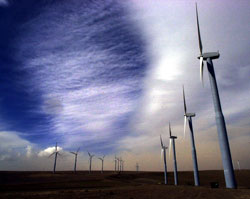Wind energy: Texas ahead of California
 As the U.S. wind energy industry stayed on pace for another record year, Texas for the first time supplanted historic leader California as the top state in cumulative wind power capacity, according to the American Wind Energy Association’s (AWEA) Second Quarter Market Report.
As the U.S. wind energy industry stayed on pace for another record year, Texas for the first time supplanted historic leader California as the top state in cumulative wind power capacity, according to the American Wind Energy Association’s (AWEA) Second Quarter Market Report. The report also shows that U.S. developers brought online a capacity total of 822 megawatts (MW) in the first half of the year. With the strong growth, the U.S.’s cumulative wind power capacity surged to 9,971 MW—within close striking distance of the 10-gigawatt (10,000-MW) milestone. (For a listing of projects completed and under construction, see below.)
Texas ’s cumulative total now stands at 2,370 MW of capacity—enough to power over 600,000 average American homes—followed by California’s 2,323 MW. Texas edged ahead of California by adding a total of 375 MW, about half of the total amount installed in the country since the beginning of the year.
It’s a historic moment. California has led the nation in installed wind capacity uninterruptedly for nearly 25 years, ever since the first wind farms were built there in late 1981, and at one time the Golden State was host to more than 80 percent of the wind capacity in the entire world. However, energy and electricity prices tanked during the global oil glut of the 1980s, putting California’s wind power boom on hold.
But Texas by no means has been the lone state busy developing wind power projects. In fact, while Texas took the capacity crown from the perennial state leader, development activity in California has not exactly been dormant, with PPM Energy’s (PPM) 150-MW Shiloh Wind Project in Solano County and the Sacramento Municipal Utility District’s 24-MW project near Rio Vista coming online earlier in the year.
Developers continue their steady advance in project activity while the industry confronts a series of inevitable challenges, one being the interplay between wind turbines and military radar. At AWEA’s annual conference, the WINDPOWER 2006 Conference & Exhibition in June, industry players gathered for a siting panel on military issues, an event that brought together stakeholders from all sides of the radar issue. At the session Lt. Col. William Crowe, chief of airspace for the U.S. Air Force, offered to serve as a point of contact for the industry as the various parties work through the challenges and concerns.
read more: AWEA quarterly market report







0 Comments:
Post a Comment
<< Home